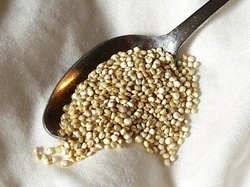Quinoa
|
|
| Quinoa | ||||||||||||||
|---|---|---|---|---|---|---|---|---|---|---|---|---|---|---|
 | ||||||||||||||
| Scientific classification | ||||||||||||||
|
Quinoa is a species of goosefoot grown primarily as a cereal crop. Its leaves may also be eaten as a leaf vegetable much like amaranth, but the commercial availability of quinoa greens is currently limited.
Quinoa comes from the Andean region of South America, where it has been an important food for 6,000 years. Quinoa is generally undemanding and altitude-hardy, so it can be easily cultivated in the Andes up to about 4,000 meters. Even so, it grows best in well-drained soils and requires a relatively long growing season. In eastern North America, it is susceptible to a leaf miner that may reduce crop success; this leaf miner also affects the common weed Chenopodium album, but C. album is much more resistant.
Similar Chenopodium species were probably grown in North America before corn agriculture became popular. Chenopodiums were also used in Europe as greens. Lambsquarter (Chenopodium album) which has a widespread distribution in the United States, produces edible seeds and greens much like quinoa, but in lower quantities. Caution should be exercised in collecting this weed, however, because when growing in heavily fertilized agricultural fields it can accumulate dangerously high concentrations of nitrates.
In colonial times, quinoa was scorned by the Spanish colonists as "food for Indians," but in contemporary times the grain has come to be highly appreciated for its nutritional value. Unlike wheat or rice, quinoa contains a full complement of the amino acids the human body can't produce itself, making it an unusually complete foodstuff. It also contains essential omega-3 fatty acids, which provide benefit to the heart.
In its natural state quinoa has a coating of bitter-tasting saponins, making it essentially unpalatable. Most quinoa sold commercially in North America has been processed to remove this coating. Some have speculated that this bitter coating may have caused the Europeans who first encountered quinoa to reject it as a food source, even as they adopted other indigenous products of the Americas like corn and potatoes.
Preparation
Quinoa is an easy grain to prepare, requiring no more than ten minutes of boiling for a light, fluffy texture with a slight butternut flavour. During cooking, the germ comes out of the seed and dangles, curled from it, or falls off. Most North Americans prepare one cup dry quinoa in four cups of water and two of stock for accentuation of natural flavours. Once drained with a sieve, this method will yield three cups cooked grain. Quinoa also makes an excellent breakfast cereal mixed with honey, almonds or berries; it is also sold as a dry cereal product, much like corn flakes. It is also well-suited to vegetable pilafs, complementing bitter greens like kale.
Another preparation method is to treat quinoa much like rice, bringing two cups of water to a boil with one cup of grain, covering at a low simmer and cooking 15 minutes until the water is absorbed. Alternatively, one can use a rice cooker to prepare quinoa. Vegetables and seasonings can also be added to make a wide range of dishes.
Unprocessed quinoa can be made palatable by rinsing it in ample running water either in a fine strainer or in cheesecloth, and then cooking via the desired method.
There has been at least a couple documented cases of persons who have ingested quinoa that have had violent allergic reactions. The exact cause is unknown.da:Quinoa (Chenopodium quinoa) de:Quinoa es:Quinua fr:Quinoa zh:藜麥
